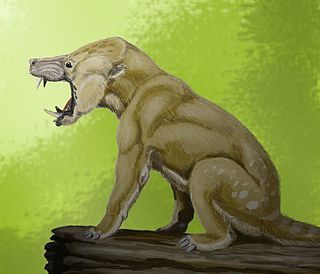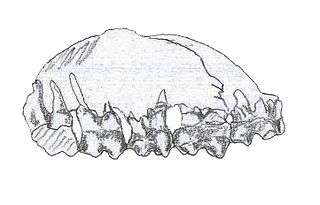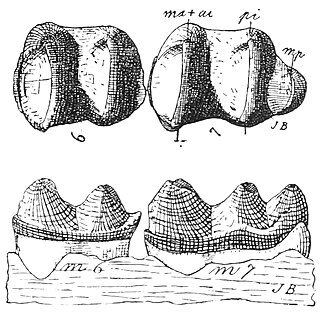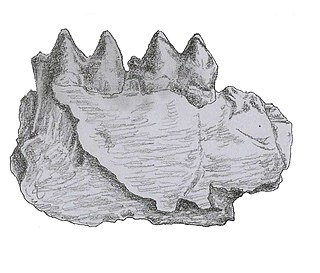Ferugliotherium is a genus of fossil mammals in the family Ferugliotheriidae from the Campanian and/or Maastrichtian period of Argentina. It contains a single species, Ferugliotherium windhauseni, which was first described in 1986. Although originally interpreted on the basis of a single brachydont (low-crowned) molar as a member of Multituberculata, an extinct group of small, rodent-like mammals, it was recognized as related to the hypsodont (high-crowned) Sudamericidae following the discovery of additional material in the early 1990s. After a jaw of the sudamericid Sudamerica was described in 1999, these animals were no longer considered to be multituberculates and a few fossils that were previously considered to be Ferugliotherium were assigned to unspecified multituberculates instead. Since 2005, a relationship between gondwanatheres and multituberculates has again received support. A closely related animal, Trapalcotherium, was described in 2009 on the basis of a single tooth.
Ferugliotheriidae is one of three known families in the order Gondwanatheria, an enigmatic group of extinct mammals. Gondwanatheres have been classified as a group of uncertain affinities or as members of Multituberculata, a major extinct mammalian order. The best-known representative of Ferugliotheriidae is the genus Ferugliotherium from the Late Cretaceous epoch in Argentina. A second genus, Trapalcotherium, is known from a single tooth, a first lower molariform, from a different Late Cretaceous Argentinean locality. Another genus known from a single tooth, Argentodites, was first described as an unrelated multituberculate, but later identified as possibly related to Ferugliotherium. Finally, a single tooth from the Paleogene of Peru, LACM 149371, perhaps a last upper molariform, and a recent specimen from Mexico, may represent related animals.

Pyrotheria is an order of extinct meridiungulate mammals. These elephant-like ungulates include the genera Baguatherium, Carolozittelia, Colombitherium, Griphodon, Propyrotherium, Proticia, and Pyrotherium.

Pyrotheriidae is the only family in the order Pyrotheria, provided one does not include the Paleocene genus, Carodnia. These extinct, elephant-like ungulates include the genera Baguatherium, Carolozittelia, Griphodon, Propyrotherium, and Pyrotherium. Fossils of the family have been found in Argentina, Brazil, Bolivia and Peru.

Pyrotherium is an extinct genus of South American ungulate, of the order Pyrotheria, that lived in what is now Argentina and Bolivia, during the Late Oligocene. It was named Pyrotherium because the first specimens were excavated from an ancient volcanic ash deposit. Fossils of the genus have been found in the Deseado and Sarmiento Formations of Argentina and the Salla Formation of Bolivia.

Arctocyon is an extinct genus of ungulate mammals. Arctocyon was a "ground dwelling omnivore", that lived from 61.3-56.8 Ma. Synonyms of Arctocyon include Claenodon, and Neoclaenodon. Arctocyon was likely plantigrade, meaning that it walked with its feet flat on the ground, rather than on its toes.

Colombitherium is an extinct mammal from Late Eocene Colombia. It has originally been assigned to the order Pyrotheria and the family Colombitheriidae, although a later detailed analysis of the fossil questions that classification. A fossil jawbone of approximately 9 centimetres (3.5 in) length of Colombitherium has been found by Texas Petroleum in 1945, in the Upper Eocene strata of the middle Gualanday Group in the department of Tolima, Central Ranges of the Colombian Andes.

Prosotherium is an extinct genus of hegetotheriid notoungulate. It lived during the Late Oligocene, and its fossilized remains were found in South America.

Proticia is an extinct genus of mammals belonging to the order Pyrotheria. It lived during the Early Eocene, and its fossilized remains were discovered in South America.
Rodcania is an extinct genus of mammal, belonging to the order Xenungulata. It contains a single species, Rodcania kakan, which lived during the Paleocene. Its remains were found in South America. The genus name is an anagram of Carodnia.

Carolozittelia is an extinct genus of mammals, belonging to the order Pyrotheria. It contains the single species Carolozittelia tapiroides which lived during the Early Eocene. Its fossilized remains were found in South America.

Griphodon is an extinct genus of mammals, belonging to the order Pyrotheria. It lived during the Middle Eocene, in what is now Peru.
Propyrotherium is an extinct genus of mammals, belonging to the order Pyrotheria. It lived during the Late Eocene, in what is now South America.

Trachytherus is an extinct genus of mesotheriid notoungulate that lived from the Late Oligocene to the Early Miocene in what is now South America.

Eomorphippus is an extinct genus of notohippid notoungulate that lived from the Late Eocene to the Early Oligocene in what is today South America.
Archaeopithecus is an extinct genus of notoungulate, belonging to the suborder Typotheria. It lived during the Middle Eocene, in what is today Argentina.

Proeutatus is an extinct genus of xenarthran, belonging to the order Cingulata. It lived during the Early Miocene, and its fossilized remains were discovered in South America.
Fredszalaya is an extinct genus of omnivorous mammal, belonging to the order Sparassodonta. It lived during the Late Oligocene, and its fossilized remains were discovered in South America.
Australohyaena is an extinct genus of carnivorous mammal, belonging to the order Sparassodonta. It lived during the Late Oligocene, and its fossilized remains were discovered in Argentina.
Rosendo is an extinct genus of notohippid notoungulates that lived during the Early Oligocene in what is now Argentina and Chile. Fossils of this genus have been found in the Sarmiento Formation and the Abanico Formations of Argentina and Chile.



















